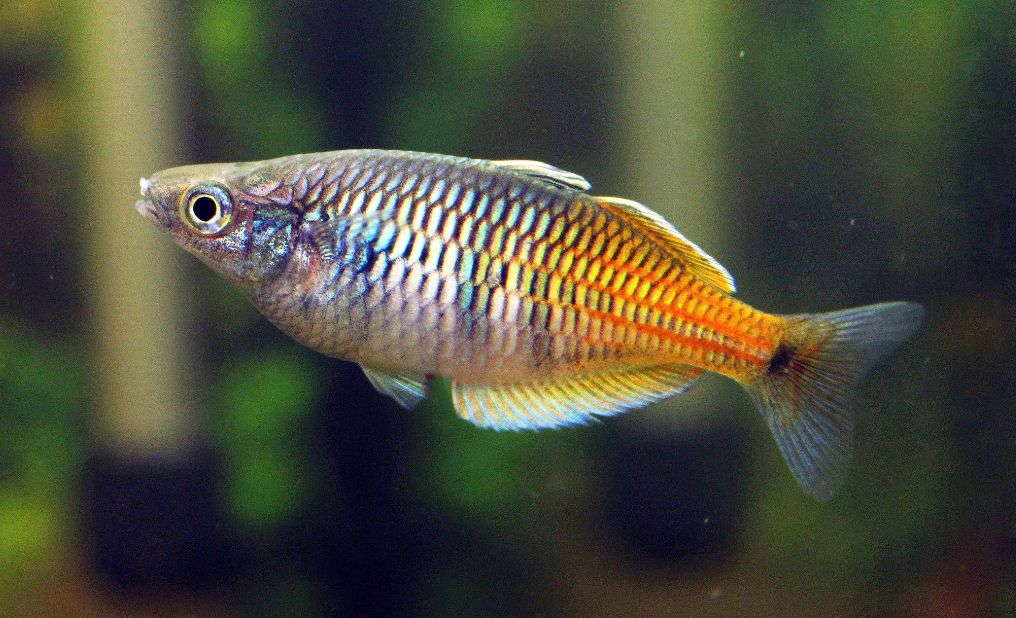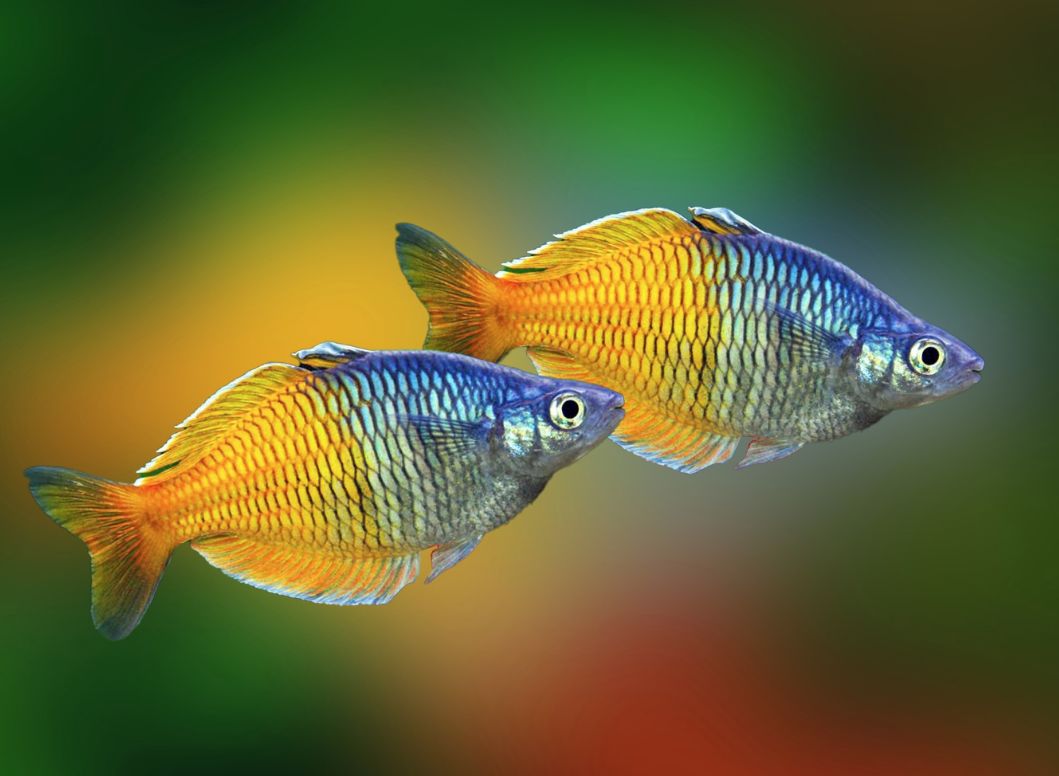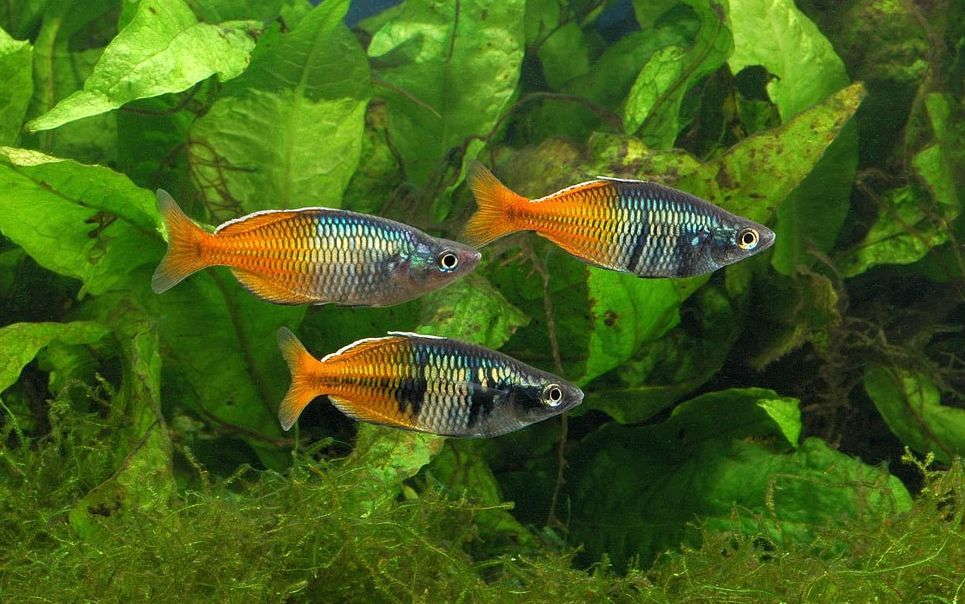The Boesemani Rainbowfish (Melanotaenia boesemani) is a popular and colorful freshwater fish species that is native to the island of New Guinea. This is a bright, active and schooling fish. It is quite challenging in terms of keeping, therefore it’s not recommended for beginner aquarists.

Contents
Habitat in the wild
Boesemani rainbow (Melanotaenia boesemani) comes from Melanotaeniidae family. It is named after the Dutch ichthyologist Marinus Boeseman, who described the species in the 1960s.
The boesemani rainbowfish inhabits West part of New Guinea (West Papua) island, the territory of today’s Indonesia, specifically the Ayamaru Lakes region in the Vogelkop Peninsula of West Papua (formerly known as Irian Jaya). Only three habitats of the fish are known nowadays. These are three lakes known as Ajamaru, Hain and Aitinjo.
The fish prefers shallow waters with thickly growing aquatic vegetation. These fish tend to stay among the plants where they feed on vegetation and insects. The water in their natural habitat is typically clear and slightly acidic to neutral, with a pH range of around 6.5 to 7.5. The water temperature generally ranges between 75°F and 82°F (24°C to 28°C).
Description
Body and color
This boesemani rainbowfish has tall, flattened, ellipsoid-shaped body. Its dorsal consists of two parts: small one and elongated one. The anal fin is symmetrical to the elongated part of the dorsal. The tail fin is forked, the head is narrow with large eyes. The body coloring is quite unusual – its head and the part of the body behind it is light blue, which transforms into yellow-orange color starting from the middle of the body to its tail. The males are more colorful than the females, displaying bright hues of blue, purple, orange, and yellow along their body. The colors intensify and become more prominent during courtship and breeding.
Size
How big do boesemani rainbow fish get?
Boesemani Rainbowfish (Melanotaenia boesemani) can reach a size of approximately 4-5 inches (10-13 cm) in length. Males tend to be slightly larger than females. It’s important to provide adequate space for these fish in the aquarium, taking into consideration their eventual size.
Lifespan
How long do boesemani rainbow fish live?
Boesemani rainbowfish typically have a lifespan of around 5 to 8 years in captivity when provided with proper care. However, it’s important to note that individual lifespans can vary depending on various factors, including water quality, diet, genetics, and overall tank conditions.
| Characteristic | Description |
|---|---|
| Scientific Name | Melanotaenia boesemani |
| Common Name | Boesemani Rainbowfish |
| Native Habitat | Ayamaru Lakes region, New Guinea |
| Size | Up to 4-5 inches (10-13 cm) in length |
| Lifespan | Typically 5-8 years in captivity |
| Colors | Males: Vibrant hues of blue, purple, orange, and yellow |
| Females: Less vibrant, silver-gray with hints of color | |
| Temperament | Generally peaceful and non-aggressive |
| Water Parameters | Temperature: 75-82°F (24-28°C), pH: 6.5-7.5 |
| Diet | Omnivorous, accepts high-quality flakes, pellets, and live/frozen foods |
| Tank Size | Minimum 30 gallons (114 liters) for a small group |
| Tank Setup | Dense vegetation, rocks, and driftwood for hiding spots |
| Compatibility | Peaceful community fish, prefers similar-sized tankmates |
| Breeding | Egg-layers, require a separate breeding tank with plants |
| Conservation Status | Not currently listed as endangered or threatened |

Difficulties in keeping
The boesemani rainbowfish is rather demanding in terms of feeding and keeping conditions. It requires stable tank water parameters and quality food. For this reason, the fish isn’t recommended for beginners, since to keep it successfully you need some experience and ability to maintain tank water parameters stable.
Care and keeping in a tank
Tank size
Are rainbowfish schooling fish? How many rainbow fish should be kept together?
Considering that the fish prefers having a company of its kind, it’s better to keep it in a school of at least 6-8 species or more together to promote their natural behavior, reduce stress, and enhance their overall well-being. By maintaining a group, you’ll also have a better chance of observing their interesting social interactions and vibrant colors.. This way the fish demonstrates brighter coloring and natural behavior features. The tank should be elongated and large.
Of course, the exact number of Rainbowfish you can keep together will depend on the size of your aquarium and its capacity to accommodate them comfortably. As a general guideline, provide a tank size of at least 30 gallons (114 liters) for a small group of Boesemani Rainbowfish. This will provide them with ample swimming space and reduce territorial disputes. It’s important to introduce new fish gradually to an established group to minimize aggression and establish a hierarchy. This can be done by adding multiple individuals at once or by adding a few new fish over time. Ensuring that the male-to-female ratio is balanced can also help reduce aggression among males.
Tank decor
The boesemani rainbowfish feels comfortable in tanks with large number of tank plants, but at that they should have plant free areas for the fish to swim. Sandy bottom, lots of plants and snags – this is a biotope that resembles New Guinea waters.
As for the tank plants, choose small leaved ones and put them along the tank perimeter to leave the area to swim. To prevent the fish jumping out of the tank, the latter should have a lid. Intensive filtration and aeration, proper lighting as well as weekly renew of 1/3 of tank water is a must.
Water parameters
The boesemani rainbow is quite sensitive to water parameters and ammonia and nitrates content in the tank water. It is desirable to use external filter, at that the fish likes presence of the water flow is a tank, so you don’t have to reduce the flow rate.
Here are the proper tank water parameters: temperature 75-82°F (24-28°C), pH: 6.5-7.5 , 8 — 25 dGH. If you don’t provide the fish with favorable tank conditions, its coloring will become dim and the boesemani rainbowfish will look less appealing.

Diet
Boesemani rainbowfish are omnivorous fish. This fish species isn’t demanding in terms of food and it’ll eat all types of popular fish food – artificial, live and frozen one.
However, quality and composition of the food has a direct impact on the fish coloring, that’s why it is recommended to use only high quality food of well known manufacturers and regularly (at least once a week) give live food to the boesemani rainbowfish (for example, tubifex or bloodworm).
High-quality flakes or pellets formulated for tropical fish can serve as the staple diet for Boesemani Rainbowfish. Look for brands that offer a balanced mix of proteins, vitamins, and minerals.
Supplementing their diet with live or frozen foods is beneficial and provides additional nutrition. Offer them small live or frozen foods such as brine shrimp, daphnia, bloodworms, or mosquito larvae. These foods mimic their natural diet and are rich in proteins.
Except live food it’s desirable to enrich the diet with vegetable components. You can offer them blanched vegetables like spinach, peas, or zucchini. These can be cut into small pieces or pureed to make them easier for the fish to consume.
Tank mates
This is a peaceful and active species that gets on perfectly well with other fishes of the same size and temper, capable of living at the same tank conditions. They are generally peaceful fish that can coexist with a variety of tank mates in a community aquarium. Choose tank mates that are of similar size or larger than the Boesemani Rainbowfish. This helps prevent the Rainbowfish from being harassed or potentially becoming prey to larger, more aggressive fish.
Boesemani Rainbowfish are active swimmers, so it’s best to choose tank mates that are similarly active and occupy different areas of the water column. This helps reduce competition for swimming space and minimizes potential conflicts.
Some suitable tank mates:
- Other Rainbowfish species (e.g., Dwarf Neon Rainbowfish)
- Gouramis (e.g., Pearl Gourami, Dwarf Gourami)
- Corydoras catfish (e.g., Corydoras julii, Panda cory, Adolfo’s catfish)
- Rasboras (e.g., Harlequin Rasbora, Celestial Pearl Danio)
- Tetras (e.g., Neon Tetra, Cardinal Tetra)
- Swordtails
- Mollies
- Cherry Barb
The boesemani rainbowfish should be kept in a school of at least 6-8 species of both genders. It was noticed that males demonstrate brighter coloring if rivals are present in a tank.
Gender differences: male vs female
Male Boesemani Rainbowfish are known for their vibrant and striking colors. They typically display hues of electric blue, purple, orange, and yellow, with intense coloration on their body, fins, and tail. In contrast, female Boesemani Rainbowfish have a less vibrant coloration. They tend to be silver-gray with hints of color, and their fins are usually transparent or less brightly colored.
Males often have a more slender and streamlined body shape compared to females. Females, on the other hand, tend to have a slightly rounder and fuller body, particularly when they are carrying eggs.
Male Boesemani Rainbowfish typically have longer and more elaborate fins, especially the dorsal and anal fins. These fins may have a more exaggerated shape and elongated extensions compared to females. In general, males are slightly larger than females, both in terms of body length and overall size. However, the difference in size between males and females is not typically significant.
Breeding
Optimal conditions for breeding are the following: hard and a bit acidic water (pH 7.5), temperature 27–29°C, regular feeding with live food, small leaved and short-growing plants or artificial plants with the same characteristics.
First put one or two females into a spawning tank and several hours later put 2-3 males. The spawning period lasts for about 2 weeks and during this time the female lays several eggs among the tank plants at every turn and they stick to their leaves.
The boesemani rainbowfish male can fertilize several clutches of different females at the same time.
The boesemani rainbowfish don’t demonstrate any parental instincts. So, when the spawning is over they don’t show any concern about their offspring, however, they don’t tend to harm either their eggs or juveniles as well. But we can’t say the same about their tank mates, which can eagerly eat both the eggs and the juveniles.
In order to preserve the offspring, carefully put the eggs into another volume with the same water parameters and there the eggs will be safe. The egg stage lasts from 7 to 12 days.
During the first days of their life the juveniles will need micro sized food, such as infusorian. As the juveniles grow you can feed them with specialized powderlike food or/and brine shrimp nauplii.